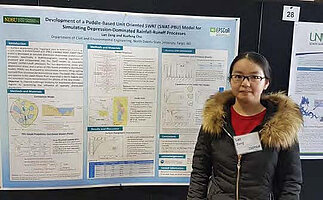Development of a puddle-based-unit oriented SWAT (SWAT-PBU) model and its application in North Dakota

Lan Zeng, second year as a Ph.D. student in the Department of Civil and Environmental Engineering at North Dakota State University. I received my B.S. degree in Hydrology and Water Resources Engineering from China University of Geosciences (Beijing) in July 2014 and continued my graduate studies in hydrogeology at China University of Geosciences (Beijing) in September 2014.
Development of a puddle-based-unit oriented SWAT (SWAT-PBU) model and its application in North Dakota
Research Abstract
Modeling of overland flow on depression-dominated surfaces is challenging due to the spatial distribution of depressions. Moreover, the hierarchical relationships between depressions and their contributing areas make the hydrologic modeling even more complicated. The objective of this 1-year project is to develop a puddle-based-unit (PBU) oriented SWAT (SWAT-PBU) model to simulate the influence of spatially distributed depressions on hydrologic processes. The SWAT-PBU will be applied to a depression-dominated site in North Dakota. In the SWAT-PBU, to consider the influence of depressions, each subbasin is divided into channel-based units (CBUs) and PBUs by using the Depression-Dominated Delineation (D-cubed) algorithm. CBUs are non-depressional areas and surface runoff from these areas is simulated by using the SCS-CN method in the original SWAT. For PBUs (depressional areas), however, a PBU-based probability distribution model (PDM) will be developed to determine the depression storage of PBUs at each simulation time step. In addition, each subbasin is further analyzed to develop the relationships of depression storage, contributing area, and outlet discharge. Finally, these relationships and the proposed PBU-based PDM will be integrated into SWAT to facilitate hydrologic modeling for depression-dominated areas. The applicability of the SWAT-PBU model will be assessed by the application to a depression-dominated site in North Dakota. The new method is useful for improving hydrologic modeling for landscapes of topographic depressions and effectively predicting hydrologic extremes (e.g., flooding).
Research Highlights:
A new puddle-based unit probability distributed model (PBU-PDM) is developed and coupled with the existing Soil and Water Assessment Tool (SWAT) for improved watershed-scale hydro-logic modeling in depression-dominated regions. In the PBU-PDM, PBUs are conceptualized as basic modeling units for depressional areas to account for the potential merge of depressions, which avoids underestimating the total maximum depression storage and overestimating surface runoff. The contributing area, depression storage, and surface runoff of depressional areas are simulated by using the probability distribution functions of depression storage capacities. Specifically, the PBU-PDM tracks the filling-spilling process and storage variations of depressions, which facilitates the simulation of variable contributing area and threshold-controlled overland flow dynamics. The PBU-PDM enhanced SWAT was applied to the upper Maple River watershed in the Prairie Pothole Region of North Dakota, and simulation results demonstrated its capability in simulating the depression-controlled surface runoff generation processes. The model also provided the seasonal varia-tions in surface runoff and the probabilities of overflows from depressions. It was found that there was a higher possibility for de-pressions to be fully filled, generating surface runoff in March - May. The PBU-PDM can be used to evaluate the influences of changing climate and land use and land cover on hydrology. It can also be integrated with other watershed-scale models to improve water quantity and quality modeling, especially in depression-dominated areas.

Dr. Xuefeng (Michael) Chu
Director, ND Water Resources Research Institute & Civil and Environmental Engineering
Office: CIE 201K
Phone: (701) 231-9758
Email: xuefeng.chu@ndsu.edu


